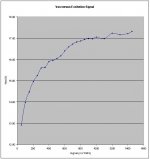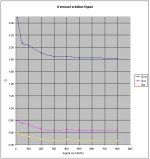George cited Joe D'Appolito:
Which is also my feeling.
But George's measurements show a falling fs with drive level. It would be interesting to find out why it is that way.
Regards
Charles
As the driver level increases especially when measuring small diameter drivers, the resonance frequency also moves upward.
Which is also my feeling.
But George's measurements show a falling fs with drive level. It would be interesting to find out why it is that way.
Regards
Charles
phase_accurate said:George cited Joe D'Appolito:
Which is also my feeling.
But George's measurements show a falling fs with drive level. It would be interesting to find out why it is that way.
Regards
Charles
Perhaps someone into driver design might be able to answer that question!
phase_accurate and soongsc please note:
The quotation:"As the driver level increases especially when measuring small diameter drivers, the resonance frequency also moves upward." is from Vance Dickason "The loudspeaker design cookbook" fourth edition-1991 Old Colony Sound Labs and not from Joseph D' Appolito "TESTING Loudspeakers" (1998 Old Colony Sound Lab)
Regards
George
The quotation:"As the driver level increases especially when measuring small diameter drivers, the resonance frequency also moves upward." is from Vance Dickason "The loudspeaker design cookbook" fourth edition-1991 Old Colony Sound Labs and not from Joseph D' Appolito "TESTING Loudspeakers" (1998 Old Colony Sound Lab)
Regards
George
gpapag said:phase_accurate and soongsc please note:
The quotation:"As the driver level increases especially when measuring small diameter drivers, the resonance frequency also moves upward." is from Vance Dickason "The loudspeaker design cookbook" fourth edition-1991 Old Colony Sound Labs and not from Joseph D' Appolito "TESTING Loudspeakers" (1998 Old Colony Sound Lab)
Regards
George
There is also a question as to what "small diameter drivers" refer to. There are so many more design combinations and material today than the day since that book had been initially released. If you consider in detail, each physical member such as the cone, the rim, the rear suspension, the volume between the dust cap and the magnet, etc. each part is a combination of mass and spring, mostly are in series. So unless one knows the specific mass and spring model, there is really no way to explain correctly the specific trend.
However, we must consider how much effect this has on the final design. This any designer can determine based on his/her own design.
This is related to the relaxation of the spider with excursion. Push a driver cone in, and hold it at a fixed location; the spring constant of the suspension will weaken over time, rather quickly. This of course means that the resonant frequency will drop.
The further you excurse the spider, the faster - and further - it relaxes.
You should also look for the jump phenomenon, whereby this behavior causes a shift in the operating parameters by a significant amount, including offset of the operational center.
Bluntly, current suspensions are pretty low tech and non-linear. It's kind of the last area to research and develop in terms of linearizing drivers.
Dan Wiggins
Adire Audio®
The further you excurse the spider, the faster - and further - it relaxes.
You should also look for the jump phenomenon, whereby this behavior causes a shift in the operating parameters by a significant amount, including offset of the operational center.
Bluntly, current suspensions are pretty low tech and non-linear. It's kind of the last area to research and develop in terms of linearizing drivers.
Dan Wiggins
Adire Audio®
Hi all
Quote from post #4:
“Besides, I was always wondering if the change in "sound character" due to breaking-in is accompanied by any measurable change in any of the speaker's parameters. I have the means to measure the Fr, so in this thread i will also report any change (if any) in Fr that i will observe with breaking-in on said speakers.”
A few days ago the burning-in with 44Hz sinusoidal signal of the JX92S reached the planed 1000 Hrs. This is a quite long burn-in period (or isn’t it?). Attached you will find the complete measurement data together with some graphs.
The verdict is that:
Fr variation with excitation signal remained the same as reported in post #1.
Fr variation for each excitation signal over time did not show any systematic trend. Only statistical variations spanning 2.5Hz for low signals (<100mV) and up to 1.5Hz for higher signals. So, no shift of resonance frequency during this 1000 Hrs can be reported.
Thank you all for commenting
Regards
George
Quote from post #4:
“Besides, I was always wondering if the change in "sound character" due to breaking-in is accompanied by any measurable change in any of the speaker's parameters. I have the means to measure the Fr, so in this thread i will also report any change (if any) in Fr that i will observe with breaking-in on said speakers.”
A few days ago the burning-in with 44Hz sinusoidal signal of the JX92S reached the planed 1000 Hrs. This is a quite long burn-in period (or isn’t it?). Attached you will find the complete measurement data together with some graphs.
The verdict is that:
Fr variation with excitation signal remained the same as reported in post #1.
Fr variation for each excitation signal over time did not show any systematic trend. Only statistical variations spanning 2.5Hz for low signals (<100mV) and up to 1.5Hz for higher signals. So, no shift of resonance frequency during this 1000 Hrs can be reported.
Thank you all for commenting
Regards
George
Attachments
Golly! We have someone in proffessional testing here!
1000 hours! Do you do that to all the drivers you work with? Sonic differences that one would normally hear would probably not show up in impedance plots.
Sonic differences that one would normally hear would probably not show up in impedance plots.
There's another thread that talks about mosturizing the spider with water or grease to change the characteristics, but I wouldn't try it on Jordans.
1000 hours! Do you do that to all the drivers you work with?
There's another thread that talks about mosturizing the spider with water or grease to change the characteristics, but I wouldn't try it on Jordans.
Hello soongsc
The answer is no. I usually burn-in my drivers for 100-200 hours. But for the Jordans things are a bit different:
First, it has been written by many that these speakers require very long exercising period and chances are that they know better. So i followed.
Second, these Jordans were purchased for to be treated in a "special way". In the course of time i have read so many positive comments about this driver, that in conjuction with it’s high price, made me build a dreamy attitude toward it. When I gave my beloved BMW R 60 Boxer motorbike to a friend six mounths ago for free just for the sake of having it repaired ( I couldn’t pay for this) and driving long jorneys ( I don’t have the time anymore), he denied unless he would pay me a symbolic amount (he was dreaming of a BMW just as I was 20 years ago). We talked about it and the smallest amount that would make him feel comfortable with this “transaction” was 500 Euros. I said him OK and these 500 Euros I said to my wife will be spent for BMW sake just for sheer pleasure. The Jordans costed appr. 350 Euros, 50 for beers upon arrival and the rest 100 are saved for enclosures costs. So as you can understand, it is gonna take a while ‘till these drivers find a place in an enclosure-if ever (there are two stereo systems at home, to which I don’t listen to due to family and time restrictions, all the listening is through AKG headphones during the small hours)
Regards
George
The answer is no. I usually burn-in my drivers for 100-200 hours. But for the Jordans things are a bit different:
First, it has been written by many that these speakers require very long exercising period and chances are that they know better. So i followed.
Second, these Jordans were purchased for to be treated in a "special way". In the course of time i have read so many positive comments about this driver, that in conjuction with it’s high price, made me build a dreamy attitude toward it. When I gave my beloved BMW R 60 Boxer motorbike to a friend six mounths ago for free just for the sake of having it repaired ( I couldn’t pay for this) and driving long jorneys ( I don’t have the time anymore), he denied unless he would pay me a symbolic amount (he was dreaming of a BMW just as I was 20 years ago). We talked about it and the smallest amount that would make him feel comfortable with this “transaction” was 500 Euros. I said him OK and these 500 Euros I said to my wife will be spent for BMW sake just for sheer pleasure. The Jordans costed appr. 350 Euros, 50 for beers upon arrival and the rest 100 are saved for enclosures costs. So as you can understand, it is gonna take a while ‘till these drivers find a place in an enclosure-if ever (there are two stereo systems at home, to which I don’t listen to due to family and time restrictions, all the listening is through AKG headphones during the small hours)
Regards
George
All the above measurements (Vas, Q and past Fs measurements) show results that are approaching the published specs when the excitation signal is at a higher level (>400mV RMS). The lower test signals (especially below 100mV RMS) show results far away from the published data and at the same time quite sensitive to small signal variations. This, together with the fact that listening levels are produced by a signal of not less than 300mV RMS on these speakers, makes me choose the higher signal level characteristics, these of around 500mV RMS.
Regards
George
Regards
George
gpapag said:Hi all
I took the time to do some more manual measurements to check for any change occurring to Q and Vas of the JX92S relative to excitation signal.
Results below:
Vas increases across the full span of applied signal.
How do you determine VAS? This is not directly measured.
Quote from soongsc:"How do you determine VAS? This is not directly measured."
Vas is determined using the closed box method. An unstuffed closed box with volume Vb<Vas/2 is used:
1. Measure Free air resonance freq. of driver (fs)
2. Measure In-Box resonance freq. of driver (fct). Both measurements with exactly the same signal amplitude
3. Calculate Vas=1.15[(fct/fs)^2 -1]Vb
Method is referenced in Vance Dickason “Loudspeaker Cookbook” fourth Edition pages 131-132 and David Weems “Great Sound Stereo Speaker Manual” first Edition page 208
Vas data as well as Q data and Fr data at the attachment. (Color at the columns represent: Blue=Set data, Yellow=Measured data, Green=Calculated data).
Regards
George
Vas is determined using the closed box method. An unstuffed closed box with volume Vb<Vas/2 is used:
1. Measure Free air resonance freq. of driver (fs)
2. Measure In-Box resonance freq. of driver (fct). Both measurements with exactly the same signal amplitude
3. Calculate Vas=1.15[(fct/fs)^2 -1]Vb
Method is referenced in Vance Dickason “Loudspeaker Cookbook” fourth Edition pages 131-132 and David Weems “Great Sound Stereo Speaker Manual” first Edition page 208
Vas data as well as Q data and Fr data at the attachment. (Color at the columns represent: Blue=Set data, Yellow=Measured data, Green=Calculated data).
Regards
George
Attachments
- Status
- This old topic is closed. If you want to reopen this topic, contact a moderator using the "Report Post" button.
- Home
- Loudspeakers
- Full Range
- Speaker's Fr variation with signal level

